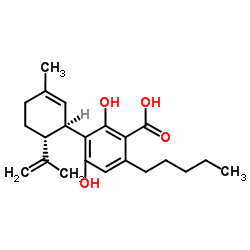Cannabidiolic acid prevents vomiting in Suncus murinus and nausea-induced behaviour in rats by enhancing 5-HT1A receptor activation.
D Bolognini, E M Rock, N L Cluny, M G Cascio, C L Limebeer, M Duncan, C G Stott, F A Javid, L A Parker, R G Pertwee
Index: Br. J. Pharmacol. 168(6) , 1456-70, (2013)
Full Text: HTML
Abstract
To evaluate the ability of cannabidiolic acid (CBDA) to reduce nausea and vomiting and enhance 5-HT(1A) receptor activation in animal models.We investigated the effect of CBDA on (i) lithium chloride (LiCl)-induced conditioned gaping to a flavour (nausea-induced behaviour) or a context (model of anticipatory nausea) in rats; (ii) saccharin palatability in rats; (iii) motion-, LiCl- or cisplatin-induced vomiting in house musk shrews (Suncus murinus); and (iv) rat brainstem 5-HT(1A) receptor activation by 8-hydroxy-2-(di-n-propylamino)tetralin (8-OH-DPAT) and mouse whole brain CB(1) receptor activation by CP55940, using [³⁵S]GTPγS-binding assays.In shrews, CBDA (0.1 and/or 0.5 mg·kg⁻¹ i.p.) reduced toxin- and motion-induced vomiting, and increased the onset latency of the first motion-induced emetic episode. In rats, CBDA (0.01 and 0.1 mg·kg⁻¹ i.p.) suppressed LiCl- and context-induced conditioned gaping, effects that were blocked by the 5-HT(1A) receptor antagonist, WAY100635 (0.1 mg·kg⁻¹ i.p.), and, at 0.01 mg·kg⁻¹ i.p., enhanced saccharin palatability. CBDA-induced suppression of LiCl-induced conditioned gaping was unaffected by the CB₁ receptor antagonist, SR141716A (1 mg·kg⁻¹ i.p.). In vitro, CBDA (0.1-100 nM) increased the E(max) of 8-OH-DPAT.Compared with cannabidiol, CBDA displays significantly greater potency at inhibiting vomiting in shrews and nausea in rats, and at enhancing 5-HT(1A) receptor activation, an action that accounts for its ability to attenuate conditioned gaping in rats. Consequently, CBDA shows promise as a treatment for nausea and vomiting, including anticipatory nausea for which no specific therapy is currently available.© 2012 The Authors. British Journal of Pharmacology © 2012 The British Pharmacological Society.
Related Compounds
| Structure | Name/CAS No. | Molecular Formula | Articles |
|---|---|---|---|
 |
CBDA
CAS:1244-58-2 |
C22H30O4 |
|
Development and Validation of a Reliable and Robust Method f...
2015-01-01 [J. AOAC Int. 98 , 1503-22, (2015)] |
|
Medicinal Cannabis: In Vitro Validation of Vaporizers for th...
2016-01-01 [PLoS ONE 11 , e0147286, (2016)] |
|
Metabolomic differentiation of Cannabis sativa cultivars usi...
2004-06-01 [J. Nat. Prod. 67(6) , 953-7, (2004)] |
|
Neuromotor tolerability and behavioural characterisation of ...
2016-01-01 [Psychopharmacology 233 , 243-54, (2016)] |
|
Growth characteristics of Cannabis sativa L. cultivated in a...
2004-01-01 [Kokuritsu Iyakuhin Shokuhin Eisei Kenkyusho. Hokoku. (122) , 16-20, (2004)] |